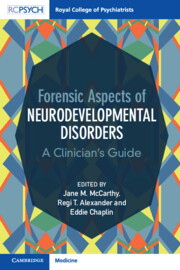Book contents
- Forensic Aspects of Neurodevelopmental Disorders
- Forensic Aspects of Neurodevelopmental Disorders
- Copyright page
- About the Cover Page
- Contents
- Contributors
- Foreword by the Rt Hon Lord Bradley
- Terminology Used in the Book
- Section 1 An Overview: Definitions, Epidemiology and Policy Issues
- Section 2 Assessment and Therapeutic Approach
- Chapter 11 Attention Deficit Hyperactivity Disorder: Assessment and Therapeutic Approaches within Forensic Settings
- Chapter 12 Autism Spectrum Disorder: Assessment and Therapeutic Approaches within Forensic Settings
- Chapter 13 Intellectual Disability: Assessment and Therapeutic Approaches within Forensic Settings
- Chapter 14 Risk Assessments in People with Neurodevelopmental Disorders
- Chapter 15 Assessment and Treatment of Young Offenders
- Section 3 Criminal Justice Pathways and Legal Issues
- Index
- References
Chapter 11 - Attention Deficit Hyperactivity Disorder: Assessment and Therapeutic Approaches within Forensic Settings
from Section 2 - Assessment and Therapeutic Approach
Published online by Cambridge University Press: 18 May 2023
- Forensic Aspects of Neurodevelopmental Disorders
- Forensic Aspects of Neurodevelopmental Disorders
- Copyright page
- About the Cover Page
- Contents
- Contributors
- Foreword by the Rt Hon Lord Bradley
- Terminology Used in the Book
- Section 1 An Overview: Definitions, Epidemiology and Policy Issues
- Section 2 Assessment and Therapeutic Approach
- Chapter 11 Attention Deficit Hyperactivity Disorder: Assessment and Therapeutic Approaches within Forensic Settings
- Chapter 12 Autism Spectrum Disorder: Assessment and Therapeutic Approaches within Forensic Settings
- Chapter 13 Intellectual Disability: Assessment and Therapeutic Approaches within Forensic Settings
- Chapter 14 Risk Assessments in People with Neurodevelopmental Disorders
- Chapter 15 Assessment and Treatment of Young Offenders
- Section 3 Criminal Justice Pathways and Legal Issues
- Index
- References
Summary
The significantly high prevalence of attention deficit hyperactivity disorder (ADHD) in prison populations raises the importance of assessment and treatment. Identification of prisoners for ADHD using screening tools is helpful. Those who are screened positive for ADHD can then undergo a full psychiatric assessment to confirm the diagnosis. The assessment also needs to focus on other potential comorbid mental disorders given the high prevalence of autism, intellectual disability, mental illness and personality disorders in prison/forensic population. Presence of comorbid mental disorders can also complicate the diagnostic process for ADHD. Treatment of ADHD is important given the strong evidence base for pharmacological treatment outcomes. Treatment needs to be personalised, taking into account many different factors. Stimulant or non-stimulant medications can be used, non-pharmacological interventions need to be offered alongside pharmacological treatments. Treatment of other comorbid mental disorders is equally important to achieve better outcomes. These may include pharmacological, psychological and social interventions within and when released from prison/forensic settings.
- Type
- Chapter
- Information
- Forensic Aspects of Neurodevelopmental DisordersA Clinician's Guide, pp. 125 - 136Publisher: Cambridge University PressPrint publication year: 2023



